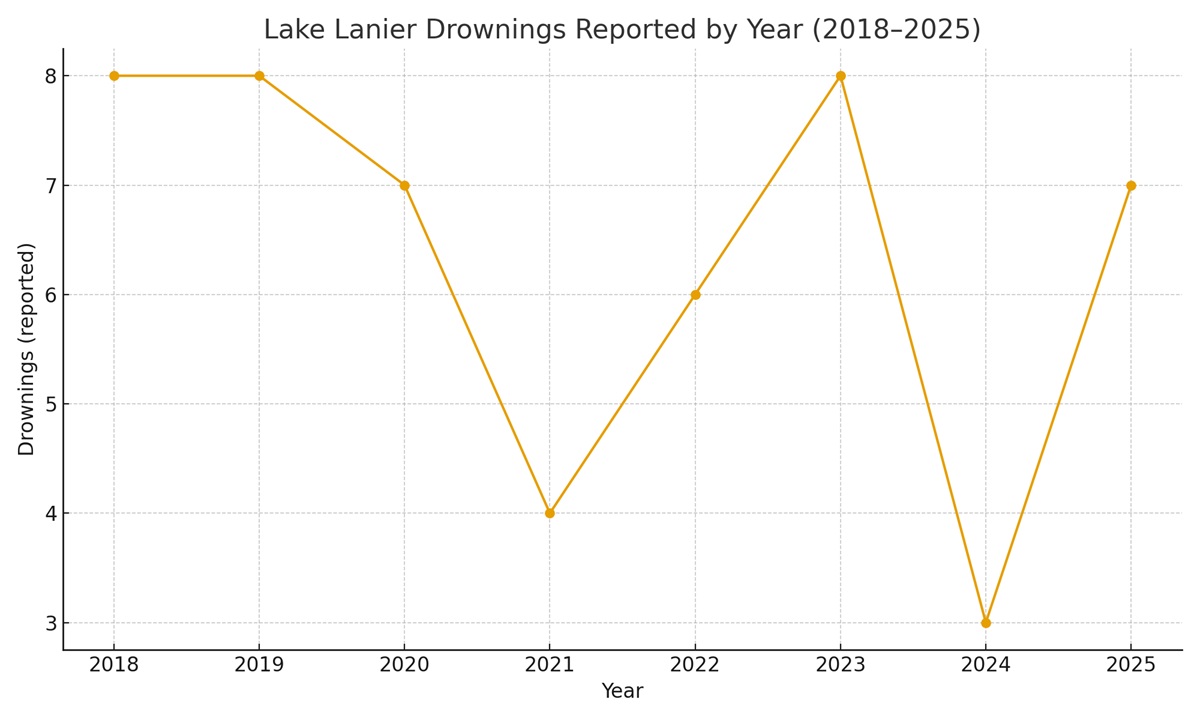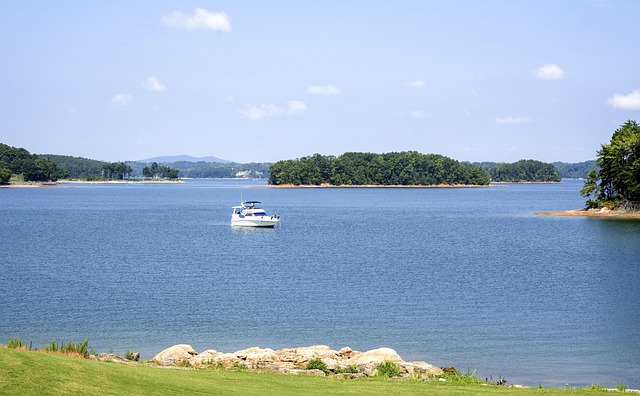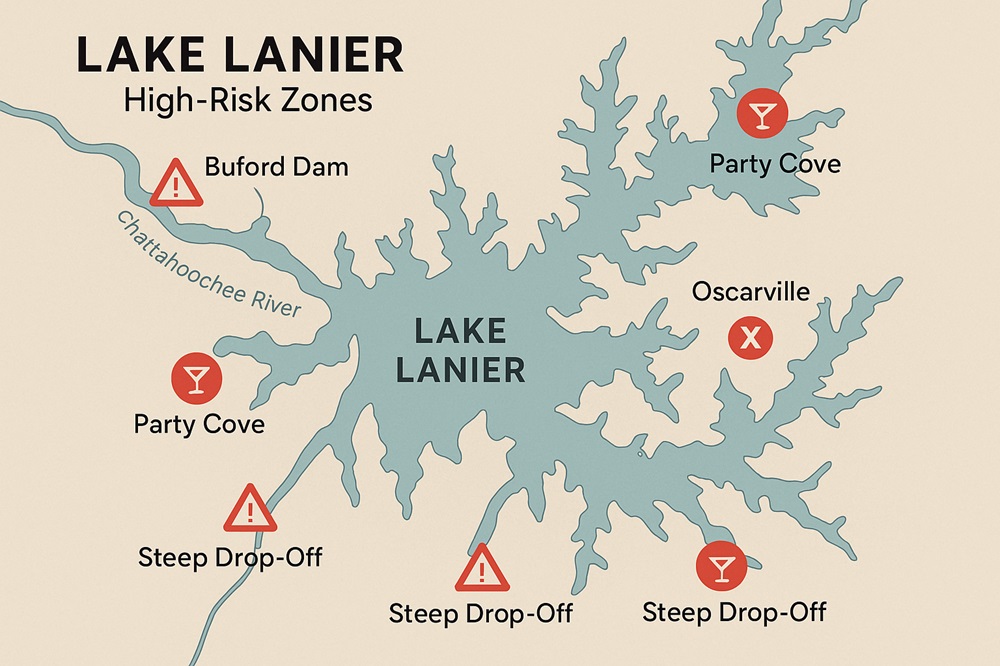Lake Lanier isn’t just Georgia’s most visited lake — it’s one of the most talked-about in the U.S. Every summer, more than 10 million visitors come to its 38,000 acres of water for fishing, boating, swimming, and lakeside parties.
But beneath its surface lies a darker story: hundreds of reported deaths, eerie legends, submerged towns, and safety risks that have earned it the title of “America’s Deadliest Lake.”
This editorial takes a closer look at the numbers, the history, and the ongoing debate over whether Lake Lanier is simply dangerous — or cursed.
Lake Lanier at a Glance
- Official Name: Lake Sidney Lanier
- Created: 1950s by damming the Chattahoochee River with Buford Dam
- Size: 38,000 acres of water, 700 miles of shoreline
- Uses: Drinking water, hydroelectric power, flood control, recreation, and tourism
- Visitors: 10–12 million per year
Quick fact: Lake Lanier draws more annual visitors than Yellowstone National Park.
How Many Deaths Have Occurred at Lake Lanier?
The numbers vary depending on the source:
- Since creation (1957): Reports suggest 700+ deaths overall.
- Since 1994 (verified): Georgia DNR confirms 200+ fatalities, with most caused by drowning.
- Annual average: Between 15–20 deaths per year, far higher than comparable U.S. lakes.

Quick answer: Yes, Lake Lanier has seen hundreds of deaths since its creation, averaging 15–20 per year, primarily from drowning and boating accidents.
Recent Tragedies That Made Headlines
- June 2025 – Ramon Diaz-Soria (27): Drowned after jumping from a boat without a secured life jacket. (People.com)
- May 2024 – Matthew Mayo (73): Fell from a bass boat; recovered using sonar. (People.com)
- Summer 2023 – Multiple Fatalities: A 24-year-old electrocuted near a dock, plus two separate drownings in one weekend. (WSB-TV Atlanta)
These cases highlight a troubling trend: victims range in age from young adults to seniors, and most were not wearing life jackets.
Common Causes of Accidents and Deaths
Why do so many tragedies occur at Lake Lanier? Experts point to several recurring factors:
- Drowning incidents: Many victims are not wearing life jackets. Strong undercurrents and sudden drop-offs add to the risk.
- Boating accidents: Crowded waters, alcohol consumption, and high-speed boats frequently contribute to collisions.
- Underwater hazards: Because Lake Lanier was formed by flooding towns and forests, submerged structures, debris, and trees still lurk beneath the surface.
- Low visibility: Murky waters make it difficult for swimmers and divers to detect danger in time.
Safety Tip: Always wear a life jacket, avoid swimming in unfamiliar or unmonitored areas, and check weather conditions before going out on the water.
Shadows and Myths
Lake Lanier carries a dark history. The lake was built over Oscarville, a Black community forced out in the early 1900s. When the dam was built and the water rose, homes, farms, churches, and even cemeteries went underwater.
Many locals believe this past adds to the lake’s haunted name. People tell stories of ghosts, strange accidents, and cursed waters. Historians say most of this is folklore, but the myths keep the idea alive that Lake Lanier is more dangerous than it seems.
How the Lake Was Made
In the 1950s, the U.S. Army Corps of Engineers built Buford Dam on the Chattahoochee River. The goal was flood control, power, and water for Atlanta. At the time, it was praised as progress.
But the cost was high. Entire towns were moved. The most famous was Oscarville, along with farms, churches, and graveyards. As the lake filled, these places were left behind. Many remain at the bottom today.
Hidden Dangers
The old buildings, trees, and debris create hidden risks for swimmers and boaters. Underwater snags, sharp objects, and sudden drop-offs make accidents more likely. Rescue teams also struggle here, since poor visibility and rough terrain make searches harder than in other lakes.
Critics also note that the flooding damaged local ecosystems and changed river flows. What was once seen as a great project is, for many, a lasting sign of loss and danger.
Why Lake Lanier Is So Dangerous
Lake Lanier is known for high accident numbers. The risk comes from both the lake itself and how people use it.
Man-Made Hazards
Lanier is not a natural lake. When Buford Dam was built in the 1950s, whole towns, forests, and cemeteries went under water. Today, concrete, trees, and debris remain at the bottom. These create hidden traps for swimmers and boaters.
The lake floor is uneven too. It can change from shallow water to deep drop-offs in just a few steps.
Murky Water and Cold Shock
The water is often cloudy. Plants and silt cut visibility down to only a few feet. This makes it hard for swimmers to see hazards and for rescuers to find victims.
The lake also has cold layers below the surface. Dropping into these icy zones can cause cold shock, panic, or even muscle freeze.
Dam-Controlled Currents
As a reservoir, Lanier’s water is managed. Sudden dam releases can create fast currents, especially near Buford Dam. Even strong swimmers may struggle, and boaters face added risks.
Human Factors
Lake Lanier is very crowded, with 10–12 million visitors a year. Heavy boat traffic, alcohol at party spots, and few safe swim areas raise the risk.
Reports show that most drowning victims were not wearing life jackets — a safety step that could save lives.
Lake Lanier’s danger comes from man-made debris, poor visibility, dam currents, and high visitor traffic. When mixed with human choices like alcohol use and no life jackets, these factors explain why accidents are so common.
The Water Level Factor: Why “Lake Lanier Water Level” Is a Safety Issue
Many search “Lake Lanier water level” — here’s why it matters:
- Low Levels: Hazards like tree stumps and old roads rise close to the surface.
- High Levels: Hazards are hidden just below, catching boaters and swimmers by surprise.
- Dam Releases: Sudden surges create strong currents.
- Seasonal Shifts: Summer crowds + drought years = riskier conditions.
Quick answer: Yes, changing water levels directly affect safety at Lake Lanier by exposing or hiding hazards and creating strong dam-controlled currents.
The Dark Reputation: Fear vs. Reality
So, is Lake Lanier truly cursed, or is it simply a case of statistics and perception? The reality is more practical than paranormal. With millions of visitors, high boating traffic, and hidden underwater dangers, accidents are bound to be more frequent.
But myths matter. For many locals, the tales of ghost towns, haunted cemeteries, and tragic deaths create a psychological weight that amplifies every incident. Whether rooted in fact or folklore, the result is the same: Lake Lanier is seen not only as a destination, but as a danger.
Economic & Community Impact
- Tourism: Despite tragedies, Lake Lanier fuels local business, real estate, and recreation.
- Safety Costs: Frequent drownings strain rescue teams and raise patrol costs.
- Public Debate: Some locals call for stricter safety laws, while others defend the lake as safe with precautions.
Safety Efforts and Community Response
The Georgia Department of Natural Resources enforces safety measures:
- Increased patrols and life-jacket checks
- Speed limit and alcohol regulations
- Warning signs near high-risk coves
Yet the lake’s vast size and heavy use make total enforcement nearly impossible.
Safety Checklist: How to Stay Safe at Lake Lanier
✅ Always wear a Coast Guard–approved life jacket
✅ Swim only in designated areas
✅ Avoid alcohol while boating or swimming
✅ Check Buford Dam water release schedules
✅ Never dive into unfamiliar waters
✅ Go with a buddy; avoid isolated swimming
FAQs About Lake Lanier
How many people have died at Lake Lanier?
Estimates suggest 700+ deaths since the 1950s, with 15–20 each year.
Is Lake Lanier haunted?
Folklore says yes, but no scientific evidence exists. Its “haunted” label stems from its submerged history.
Is it safe to swim in Lake Lanier?
Yes — but only in designated swim areas and with proper safety precautions.
What towns are under Lake Lanier?
The most notable was Oscarville, along with surrounding homes and cemeteries.
What are the most dangerous areas?
Party coves, steep drop-offs, and areas near Buford Dam with strong currents.
Conclusion
Lake Lanier is both a recreational jewel and a symbol of tragedy. Its history, construction, and human factors combine to make it uniquely dangerous compared to other U.S. lakes.
Enjoy it — but respect it. Behind the headlines and haunted tales are very real risks that demand caution.





